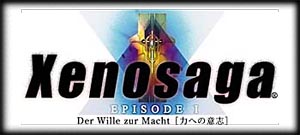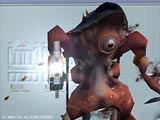
| Platform: PlayStation 2 | Publisher: NAMCO |
| Genre: Turn-Based RPG | Developer: Monolith Software | Format: DVD-ROM | Expected Release: 3/25/03 |
Namco’s Xenosaga has been the object of much speculation and debate ever since Monolith Software’s mysterious Project X was revealed to the public in 2001. The fact that most of the original Xenogears production staff defected from Square Soft to become Monolith under the auspices of Namco caused rumors to fly rampant. To add fuel to the fire, the revelation that Xenosaga was to be a series of games instead of a singular adventure had fans squeezing their copies of Xenogears Perfect Works with rapture. Many believed that Tetsuya Takahashi’s original vision outlined in the art book would finally come to fruition. Even though Takahashi-san made it evident that Xenosaga is not directly related to Xenogears, this did little to abate fan fervor. With the first chapter in the proposed six-part epic arriving on our shores in late February, RPGFan had the unique opportunity to play the current localization in progress.
Der Wille zur Macht opens at a lakeside in Kenya when an artifact known as the Zohar is excavated. Soon after, the scene flashes to 4,000 years later where the self-same monolithic crucifix is toppling through space, emblazoned with the Hebrew script “Aleph”. In an attempt to investigate the relic, an unsuspecting astronaut reaches out to touch its surface only to vanish in a flash of light. Hoping to avoid another disappearance, the remaining crewmen enlist the aid of cargo drones to take the object aboard the Woglinde, a heavily retrofitted UMN (Unus Mundus Network) space cruiser. Strangely, the captain and crew had little knowledge of the icon other than that the UMN government was eagerly seeking the retrieval of this particular piece of flotsam. The very presence of the artifact causes most of the crew to feel uncomfortable and the researchers assigned to the Zohar seem to have an agenda of their own.
Surprisingly, the monolith is not the only curious payload aboard the massive warship. Under the direction of the adorable Shion Uzuki, a small contingent of Vector Heavy Industries engineers are aboard finishing simulations on KOS-MOS, a prototype battle android designed to be a front-line weapon against the invading Gnosis. These ethereal creatures are seemingly invulnerable to physical attacks and have been a constant threat to humanity since their sudden appearance 14 years prior. By using the “Hilbert Effect”, KOS-MOS is capable of pulling the extra-dimensional beasts into the real world, thereby making them vulnerable to conventional weapons. Needless to say, the Woglinde’s classified cargo was expected to attract attention.
Drawn to the Zohar like locusts, the Gnosis descend on the warship and soon the entire vessel is swarmed. As in response to the invasion, KOS-MOS activates independently of Shion’s command and the fighting ensues. What is KOS-MOS’ directive? What exactly is the Zohar and why are the Gnosis drawn to the artifact? Why is the UMN (among others) so eager to get their hands on it? These questions and many, many more emerge in the opening hours of Xenosaga Ep. I.
Following the recent trend of console role-playing games, Monolith opted for a decidedly cinematic approach to storytelling with Der Wille zur Macht- perhaps more so than most. During the first few hours of the game, players may feel a little overwhelmed by the staggering amount of cinemas that seem to overshadow actual gameplay. Though the deluge of visual sequences has a purpose in writer/director Takahashi’s grand scheme. As the first chapter in a tale that reportedly spans millennia, setting the tone and pace was paramount. By introducing characters, both central and ancillary, as well as touching on several key concepts and subplots in the beginning, Monolith hopes to acclimate the player to an extremely involving and complex storyline. Thankfully, once the initial sequences are completed, the gameplay takes center stage.
Visually, Der Wille zur Macht is nothing short of remarkable. As a predominantly cinematic RPG, Xenosaga Ep. I is rife with slick pre-rendered FMV sequences, though the majority of plot interludes are conveyed via the in-game engine. The real-time models based on Kunihiko Tanaka’s character designs are simply incredible even though they occasionally suffer from slightly wooden animation. While Xenosaga’s backgrounds aren’t as lush as some of the more terrestrial RPG’s we’ve seen, most locations are extremely well-detailed. As the tale unfolds, one can’t help but feel the anime influence in the cinematography and art direction. Truthfully, my first impression was that the game bore more than a passing cinematic resemblance to Macross and a few of Leiji Matsumoto’s legendary space operas (Captain Harlock, Queen Emeraldas).
Eye candy aside, the most tenuous inference made about Xenosaga is probably regarding the quality of the domestic voice acting. While the Japanese release had seiyuu of extraordinary caliber, American RPG fans were skeptical that Namco would be able to preserve the integrity of the original vocal performances. After the dubbing faux pas of Tales of Destiny 2, I honestly didn’t have much faith in Namco either, but it seems that they have taken a more active interest in the localization values for Der Wille zur Macht. While no official announcements have been made regarding specific voice actors, fans of English-dubbed anime, particularly Tenchi Muyo, may find a familiar voice or two. Thus far, each character has been accurately portrayed in both text and speech. From the cold alto of KOS-MOS to the warm baritone of Ziggurat 8, the performances have ranged from admirable to astonishing. The sheer presence of Commander Marguilis’ voice actor makes him an intimidating figure irrespective of his blade. Shion is the archetypical innocent though her vocal transition into fits of anger is deliciously tangible. Even though the actors seem seasoned, there are a few instances where the subtitling and speech don’t quite go hand in hand, lending to the occasionally awkward line. Despite this minor grievance, gamers can rest assured in knowing that Namco has gathered a strong vocal cast for Monolith’s epic.
Even though Der Wille zur Macht features the traditional turn-based combat and exploration formula of most modern RPGs, the game has several unique features that enhance the experience. One of which is Shion’s PDA, a multipurpose device that is utilized throughout the course of the adventure. This handy pocket PC allows Shion to receive and send email, browse the UMN database, simulate previous environments and blow stuff up. The PDA pyrotechnics actually have a significant impact on battles as any enemy caught in the blast radius suffers penalties upon entering combat. Did I forget to mention that there are no random encounters? Rejoice!
Yasunori Mitsuda returns to score the adventure with none other than the London Philharmonic Orchestra for a soundtrack that can only be described as sublime. Sadly, the two uplifting vocal tracks sung by Joann Hogg from the import have yet to be officially confirmed for the domestic release. We strongly believe the tracks will remain unaltered as they were originally in English.
Also of note is that, at this point in the localization, the text is immaculately free of grammatical pitfalls and phonetic hijinks. Many fans feared that several of the established names from the Japanese version would suffer the inevitable translation mangling. Thankfully, the dialog integrity has been well maintained.
As the prelude to an enormous sci-fi epic, Xenosaga Episode I has an enormous task to fulfill. Not only does the game have to set the tone for what promises to be a frighteningly involved series, the success of this first chapter will determine if the rest of the saga actually sees fruition. While the game was a blockbuster in Japan and has generated an incredible amount of excitement on this side of the Pacific, will it be enough? From what we’ve seen so far, Xenosaga is holding many of the right cards: superb visuals, a magnificent score and a wicked storyline. Der Wille zur Macht is a cinematic tour-de-force that could easily establish itself as the must-have RPG of 2003. This February, prepare to stand tall and shake the heavens for a second time.
Square’s Xenogears was heralded as one of the greatest RPGs ever created. The enormous adventure wove an intricate and captivating drama filled with a complex cast of characters in what could only be described as epic. Those who played Xenogears may have realized that the game was merely a chapter in a much larger story. They say that great works of art are forever, and those responsible for that timeless tale are hoping to make gaming history once again with Xenosaga Episode I: Der Wille zur Macht (German for The Will To Power). Developed by Monolith Software, a division of Namco, the Xenosaga team is comprised mainly of staffers who defected from Square Soft not long after Xenogears' Japanese release, including Xenogears producer and writer, Tetsuya Takahashi. Monolith brings us the first installment of an epic legend. Der Wille zur Macht is loosely based off of the timeline established by Xenogears Perfect Works, a massive artbook and production manual often referred to as the Xenogears Bible by many fans. Monolith has made a few modifications and changes to the original story established in Perfect Works so fans of the story may be in for a few surprises. As the first of an enormous six-part series, Der Wille zur Macht has been eagerly anticipated by Xenogears fans and curious gamers alike since its announcement. Whether the Xenosaga series will live up to expectations of RPG fans remains to be seen.
While definitely related, it may be unfair to compare Der Wille zur Macht to Xenogears. Not only does Xenosaga's first installment take place 10-15,000 years before the events of Xenogears, the series may not be a direct linear descendant of Square Soft's 1998 sleeper hit. From what we’ve seen so far, there are distinct similarities in gameplay, character design and history. Despite similarities, Xenosaga Episode I is best judged on its own, and not as an adventure that is seemingly linked to a popular title from several years ago.
Originally touted by Namco as a space opera, Xenosaga Episode I: Der Wille zur Macht’s tale resembles a manga more than anything else. The story follows the Zohar Modifier, a relic that is central to the Perfect Works timeline. In Der Wille zur Macht, humanity has colonized the stars, forming an interplanetary alliance known as the Unis Mundus Network (UMN). When the Zohar Modifier is excavated on the planet Militia, the artifact attracts the attention of a dangerous race known as the Gnosis. Drawn to the relic for unknown reasons, the Gnosis encroach on UMN territory and war ensues. If alien invaders weren’t enough, the mysterious U-TIC organization is also trying to get their hands on the Zohar Modifier. In desperation, the UMN resorts to sealing the artifact away by casting the planet into a black hole. Sadly the confrontation doesn’t abate even after Militia is sealed away. To help combat the invaders, the UMN had developed the AGWS (Anti-Gnosis Weapon Systems), powerful mecha that have become the frontline forces for humanity as well as the Realians: genetically engineered humans sensitive to the ethereal presence of the Gnosis. As the war wages on, the UMN realizes that the AGWS aren’t an effective means of confronting the enemy and begin to develop additional countermeasures. This research eventually leads to the creation of Vector Industries’ KOS-MOS: an enhanced battle android capable of tackling the Gnosis head-on. Heading the KOS-MOS development is the young engineer, Shion Uzuki: a brilliant young woman who had lost her lover to the Gnosis in an attack. When KOS-MOS is completed, the blue-haired female android would wield extraordinary powers that even Shion could not have anticipated. On their journey to stop the Gnosis, the two young women will encounter Ziggurat8, a human-turned-cyborg hired by the Kookai Foundation and M.O.M.O., the young Realian whom he was hired to rescue from the U-TIC organization. This quartet will eventually cross paths with the enigmatic teen known as Chaos and the prepubescent called Jr.: a member of the Kookai Foundation as well as one hell of a gunslinger. Each character is said to have more depth than originally meets the eye.
The battle engine of Der Wille zur Macht is reminiscent of Xenogears, allowing players to string together attacks based on button combinations. The one difference is that the attack buttons are based on different ranges rather than degrees of strength. Additions to the combat system include being able to see the order in which characters and enemies will attack, the ability to take bonus turns and random chances to deal critical blows or earn more experience points. Xenogears players will recognize the return of Ether techniques as well as the ability to store AP points per combat round to execute special moves during battle. Characters will also earn several sets of ability points which can be used to upgrade deathblows, learn new Ether abilities and skills, as well as upgrade certain statistics. Even though Der Wille zur Macht will not feature a traditional world map, players can visit previously finished dungeons and areas by visiting a certain save point on the main ship. As always, there will be bonus dungeons, optional bosses and mini-games featured throughout the adventure.
Xenosaga Episode I's graphics engine doesn’t disappoint with some of the most impressive visuals available on the PlayStation 2. The color palette may not always be as vibrant as Final Fantasy X or Kingdom Hearts, but with Der Wille Zur Macht’s sci-fi environment, such pastels just aren’t appropriate. Xenogears character designer, Kunihiko Tanaka returns for Xenosaga Episode I and her beautiful anime illustrations are perfectly retained in 3D form with painstakingly detailed polygon models. Character animation is fluid and realistic such as KOS-MOS' flowing hair during her battle stance. Combat special effects like Chaos’ fire elemental deathblow have great animation and lighting effects in the flames. As one can imagine, some of these special effects never grow old.
Xenogears composer and renowned musical maestro, Yasunori Mitsuda, returns for Der Wille zur Macht with the help of the entire London Philharmonic Orchestra. The talented Joanne Hogg (Xenogears’ “Small Two of Pieces”) will reprise her role to sing not just one, but two ending themes for Xenosaga: Episode I. With a vast assortment of melodies ranging from lighthearted themes to darkly gothic anthems, this is a soundtrack that promises to please even the staunchest audiophile. Fans of Xenogears’ sepulchral melodies will find a quite a few memorable choral pieces such as "Miracle" throughout the game as well. Der Wille zur Macht will also feature fully-voiced, real-time and pre-rendered FMV cinemas. Sadly, no sample of the English voice acting for the US release has been made available. Since the Japanese version featured excellent vocal performances, we hope the domestic release is no less impressive.
The success of Xenosaga Episode I: Der Wille zur Macht will most likely determine the future of further episodes in North America. Given the strong development staff and promising storyline, Xenosaga may give the vaunted Final Fantasy series a serious run for its money. With enough promotion and exposure to RPG fans in North America, Xenosaga Episode I: Der Wille zur Macht could prove to be an extremely popular RPG and hopefully the beginning of a successful RPG series early next year. © 2001-2002 NAMCO Ltd., All Rights Reserved. © 2001-2002 Monolith Software Inc. All Rights Reserved. |
|









